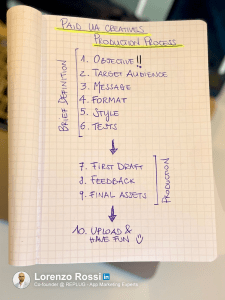Enhancing the Ad Creatives Development Process for Effective Paid Campaigns in 2024

- Wednesday, May 1st, 2024
- Share this article:
By Lorenzo Rossi, co-founder at REPLUG
Ad creatives are a foundation for the success of paid ad campaigns, as they directly influence the audience’s captivation and conversion rates. This in-depth exploration is based on over 15 years of experience crafting creative briefs for user acquisition on mobile and web platforms.
The effectiveness of an ad creative depends not just on creativity but also on the strategic support that guides its development.
Understanding the Foundation of Effective Ad Creatives
Compelling ad creatives are not the product of random creativity but are born from a strict, structured planning process that begins with a comprehensive creative brief.
This brief is crucial as it is a blueprint for the creative process, aligning every ad element with the campaign’s strategic goals and the audience’s expectations.
Related: Making Effective Creatives for Mobile App Promotion: Anatomy of the Perfect Facebook App Install Ads
The Importance of a Strong Brief
- Clarity and Direction: A detailed brief directs the creative team, ensuring that the efforts of copywriters, designers, and other stakeholders are synchronized with the campaign’s objectives.
- Efficiency and Effectiveness: The brief makes the creative process more directed and effective by clearly articulating the target audience, the intended message, and the desired action.
- Measurement and Optimization: The brief sets benchmarks that are aligned with the campaign’s goals, which helps measure success and optimize the ad based on performance data.
Crafting Your Ad Creative Brief: A Step-by-Step Guide
Creating an effective ad creative brief is a multi-step process that lays the groundwork for the campaign’s success:
- Define Your Objective: Clearly stating the goal of your campaign is crucial. The objective guides the creation process, whether increasing brand awareness, driving conversions, or re-engaging dormant users.
- Specify the Target Audience: It is crucial to deepen one’s understanding of the target audience, including demographics, interests, and behaviors. Detailed audience insights help tailor the creative elements to strike a chord with potential customers.
- Choose the Message: The core message should be impactful and directly address the needs or desires of the target audience. Whether demonstrating a product’s unique selling points or showcasing how it solves a problem, the message should be compelling and clear.
- Select the Ad Format: The choice of format—whether a simple banner, an engaging video, or an interactive carousel—should complement the message and the medium where the ad will appear. Each format has its strengths and is best suited to different types of content and audience interactions.
- Describe the Creative Style: The ad’s aesthetic elements, including imagery, color scheme, and tone, should reflect the brand’s identity and resonate with the target audience. This stylistic consistency helps maintain brand recognition across various platforms.
- Plan A/B Testing: Outline the elements you plan to test, such as different images, headlines, or calls to action. A/B testing is crucial for refining the ad creative and enhancing its performance.
Need help with setting up your brief for ad creatives? Check out our creative studio tailored precisely to your needs.
List of Essential Brief Components
| Component | Description |
| Objective | What the campaign aims to achieve |
| Target Audience | Who the ad is intended to reach |
| Message | The core message or value proposition to deliver |
| Format | The type of ad (e.g., banner, video, carousel) |
| Style | Visual and tonal style |
| A/B Testing Plans | Elements of the ad to test for optimization |
The Creative Production Phase
This phase is where strategic concepts are transformed into actual ad creatives. It involves a collaborative approach that includes:
- First Draft and Review: The initial designs bring the brief’s strategic elements into the visual realm. These drafts are reviewed to ensure they align with the brief’s directives and the campaign’s overarching goals.
- Feedback and Iterations: Constructive feedback is essential for refining the creatives. This step often involves multiple rounds of revisions, each aimed at closer alignment with the campaign’s strategic vision.
- Asset Production: Once the direction is finalized and feedback is integrated, full-scale production of the ad assets begins. This stage ensures that the creatives are polished and optimized for the platforms they will be featured on.

Launching and Managing Campaigns
Launching the campaign is only the beginning. Effective campaign management involves:
- Initial Setup and Monitoring: Proper setup is crucial for effectively reaching the intended audience. Early campaign monitoring allows for quick adjustments based on initial performance metrics.
- Continuous Optimization: Ongoing analysis and adjustments are necessary to refine the campaign and maximize its effectiveness. Engagement metrics and user feedback play critical roles in this constant optimization process.
Conclusion
Creating influential ad creatives is a complex process that requires meticulous planning, creative execution, and rigorous optimization. If you follow a structured methodology, you can ensure that the ads capture attention and drive engagement and conversions, leading to successful marketing outcomes.
For those looking to strengthen their marketing strategies, understanding and applying these principles can lead to developing high-performing ad creatives tailored to effectively captivate and convert the targeted audience.
Contact us today to learn more about our tailored solutions to captivate your target audience and drive conversions.















